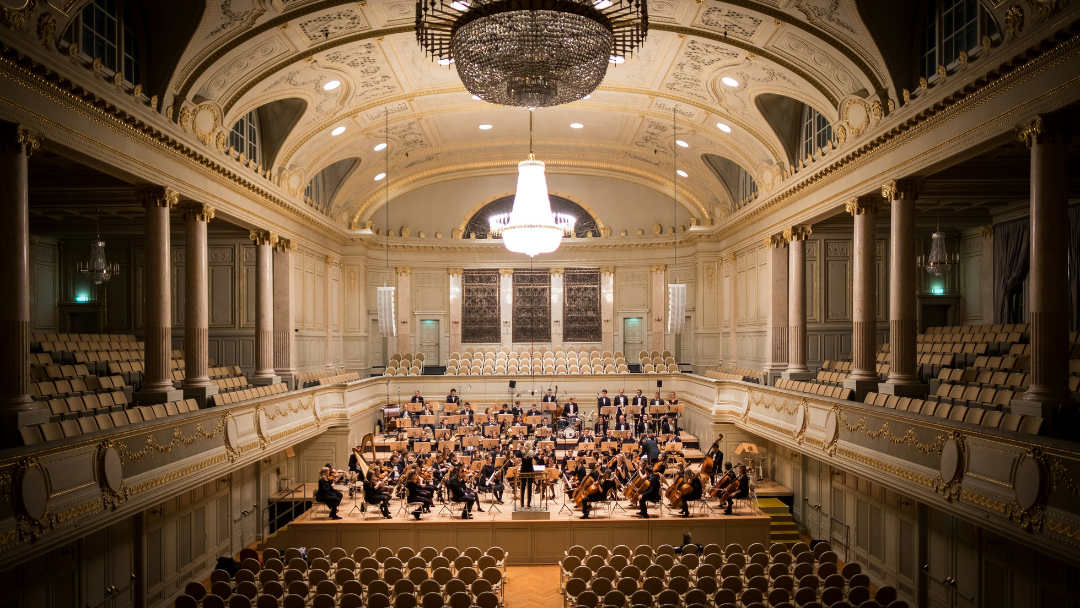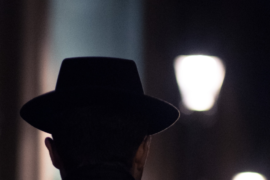O, the diabolical pleasures of Tár: the pseudonymous role, a conductor of ferocious talent, who leads the Berlin Philharmonic Orchestra and sets up a scholarship program for young women conductors to manipulate them and, in the process, betray her wife, her personal assistant, her assistant conductor who “questions her integrity,” a protégé who commits suicide, and, fait accompli, herself. And double O for its sonic pleasures: casting Cate (body, voice, face: her modulatory elasticity); Mahler’s most revelatory symphony, the Fifth; the musician Sophie Kauer who acts and plays the Elgar Cello Concerto; a catalog of ominous sounds, musical and not, bedeviling Lydia and us with its undertow; and the eclectic score, which is both “in” the film and “accompanies” it and, in turn, enchants and destabilizes the ouroboros of making a movie about a musical subject musically.
I had to watch the ending a few times to integrate it with what came before. Indeed, Tár’s musical demise is mercifully short of full-fathom; it seems fitting that she bottoms out in the Philippines while keeping her “career” going—conducting an orchestra for a Sci-Fi Cosplay convention, a gig that, at least, pays and is far enough from the European theater to be rehabilitative or noticeable. Abreast of the times, she is both canceled and on the rebound. It’s a topsy-turvy lesson that Tár’s refusal to change frenzies her as does her lark-like lack of remorse. She is music, ruthlessly adaptable. Music, that stalwart brat, who is wholly uninterested, its aesthetic free from our contemporary moral reach.
In fact, the film’s core paradox is that despite her serial lies, musical talent can’t be faked. Seeing/hearing her conduct enraptures us (her employers, her admirers, her underlings) to look/listen only to her gift, which includes her finagling behind-the-scenes the means to maintain her position. We are so charmed by her and her music-making—as is the director’s wont—that we are seldom aware of her spite, her priest-like grooming, her captivating (or intimidating) her intimates once she reaches the pinnacle. A tale as old as time, however, since pinnacles are not for perching on, they’re for falling off. Among history’s greatest conductors, vanity comes with the territory. But the machinery of symphonic performance need not be greased by ego. True, orchestras and management allow an ocean boulevard of leeway with a conductor’s sex life. While Leonard Bernstein typified the hands-on assuaging of the up-and-coming, it was the alleged sexual harassment and abuse of James Levine that proved, post-Me Too, the culture’s reckoning. Tár is a simmering, angry revenge play just as King Lear is the maddest tale of all royal tragedies. Still, the film does echo the Levine story and a corrupt overlooking of its prevalence in our musical culture. Indeed, a former opera-loving girlfriend used to say it didn’t matter how many women Placido Domingo bedded; that voice alone was worth every indiscretion.
Why linger on Tár? Simply put, it’s a marvelous illustration of the expansive language of film, here a movie with more musical and sonic intervention than any other cinema I know. I sketched out the betrayal story first to get it out of the way, since most watchers will see that as the film’s plot, its raison d’être, what audiences are instructed to follow. But that’s what the film is about, not what it is. Or, more direct, Tár is an allegory of the sonic language of film just as its subject matter is music’s seductive power, at times, to undercoat or herald what’s shown and to ease us from the dominance of watching. Music is a person (here, a woman) whose character is as ruthlessly alive as she is musically driven. Throughout, Lydia’s being is sounded, and we, participant sleuths, begin to hear how unsound she is.
This (familiar) route is taken via the movie’s plot, a classic rise, time at the top, and self-sabotaging fall. But the other story, one I hear as much as I see, is the “telling” music and sound bring to the drama. For example, early on and streaming through are an array of haunting sounds, real and dream-like, that torment her: cellphone ringing, neighbor pounding on her door, the nighttime buzzing of a refrigerator and a metronome mysteriously ticking in a cupboard, a siren, a woman screaming, as if being raped, from woods by which Lydia runs. Not only are these harbingers of things she can’t control (sounds whose insistence drive every musician mad), they also tick-tock down to her exposure as a serial orchestra manipulator and sexual abuser. It’s as if Tár is being manipulated by the materials of her craft, set to an aleatoric channel.
The destabilizing sounds are contrasted (softened and exaggerated) by “real music.” First by the performance of actual musicians: the Berlin Philharmonic Orchestra (the credits list members of the Dresden Symphony, the New Trombone Collective, and the London Symphony with recording sessions at Abbey Road studios); the cellist-actress Kauer who is seen in a video clip playing with the Moscow Youth Orchestra; and the Monster Hunter Orchestra Lydia leads in the Philippines. Second is the music played, including sections of Mahler’s Fifth, a Bach piano prelude, a couple jazz standards, “Here’s That Rainy Day” and “Lil Darlin’,” and the field recording Tár did in Peru of an indigenous piece, composed by Elisa Vargas Fernandez, called “Cura Mente,” a magic song meant to cure the mind of a sufferer who cannot stop deceiving herself and others. Curiously, this tune accompanies the film’s unusual showing of its full credits first, a turn that because of its pure text allows us to listen more intensely to the “Cura Mente” behind it. And third is the film score. Among its beguiling pieces is the atonal rapture of “For Petra,” the daughter of Lydia and her partner, a strange leaping melody written by Hildur Guđandóttir. This is the most beautiful moment for me, aside the melancholia of Mahler’s “Adagietto,” a movement that showcases grief and its evaporation. Sung by Guđandóttir, “For Petra” is the tune that Tár is writing throughout the movie, beginning as a sketch that she explores and polishes with an edit by her hoped-for lover, Sophie. It’s a case of mixing the tune of the fictional on-screen composer and the score’s composer who actualizes that work.
Listening to the chaos of sounds and the artful music is a deep pleasure for me as repeated trips through the film (four, so far) means that I see and hear more of its auditory and motional subtlety; there’s so much to hear, camera angles and interior spaces to register, facial expressions of longing and disappointment to meet and return that each time it’s to see a different movie. Such viewings also means that I’m listening less or not listening at all to the story of betrayal. The ear turned toward and away from a film, via the contrast of its sound and visual content, is a paradox itself. The music while intensifying the deception also relieves us of that deceit. What hurts less is that the musicians whose artistry has been entrusted to her are served, what hurts more is that some players are abused, those most vulnerable. This idea that music masks and reveals betrayal, its closeness to our humanity, never more obvious than when its purpose is compromised. Like the unenviable position of the Nazi-era conductor, Wilhelm Furtwängler.
The New Grove Dictionary says Furtwängler, active during the rise of Hitler and the Second World War, believed that “art could be kept apart from politics,” one reason he didn’t leave Germany like many artists and composers had before 1939. He stayed, acceding to his own wishes and others who believed German survival depended on the continued performance of “good music,” audience lost in rapture. This assessment was not true of people outside Germany who heard that he conducted concerts of the Berlin Philharmonic with Hitler in the front tow. Such patronage was immortalized with the gangly, ogrish Furtwängler on the podium conducting or bowing in several photographs: a stage decorated with Swastika banners, a great portrait of Hitler behind the orchestra, Goebbels shaking the conductor’s hand post-concert, and the most dramatic: the Fűhrer beaming with stressful pleasure at his musical leader. As a result, Americans thought Furtwängler a sympathizer if not a jackboot Nazi, a witting propagandist for the party who was programming Beethoven and Bruckner to new totalitarian ends.
The evidence, however, says that Furtwängler was hardly a politically pliant artist. There’s not much to back up the charge by the New York Times’s critic David Allen that “Despite his differences with the Nazis, it seems likely that he, like most conservatives, welcomed their takeover as a return to an authoritarian, Wilhelmine past—a process through which the art he perceived as lesser [Modernism, banned by the Nazis] would be excised.” But hold on: Consider the position the war forced on him. He was a pariah in Germany while he exemplified the superiority of German musicianship outside the country. Just because he preferred the pre-Modern doesn’t make him an authoritarian ogre. With his passport surrendered, Fűrtwangler protested mightily: he never gave the Nazi salute while crowds around him did; he pressed for the release of imprisoned Jewish musicians; he refused to conduct orchestras in occupied countries; and in 1934 he resigned his several positions after a Hindemith opera, who was a tad modernist and the Nazis labeled “degenerate,” was canceled. He may have been naïve about politics but never about the spiritual value of symphonic music.
Postwar, it was easier to revive the trifecta of Haydn, Mozart, and Beethoven for forgiving audiences than it was Furtwängler’s conducting career. Americans had to first denazify him, then turn on him as a moral traitor with the finger-wagging of the purists, which we still parlay: “He should have known better.” (He was denied posts in Chicago and New York.) Aesthetic-minded Europeans adored him unstintingly—before, during, and after the war until his death in 1954. Like his Viennese brethren, Furtwängler believed in “the eternity of the triad.” His rehabbed case is underscored by the New Grove:
His controversial position under the Third Reich has been gradually forgotten, in admiration of the revelatory splendor of his music-making at its best. Yet the two things were in a deep sense one. His social unworldliness, his inability to deal with people with whom he felt nothing in common, his indecisiveness before the practical decisions of life, his profound sense of Germanness, his obstinate belief that art had nothing to do with politics—all these and the grand idealism of his interpretations were expressions of the same nature, the same exalted philosophical outlook; they reflected the sheltered, highly civilized upbringing he had received. “With music we enter a new world,” he said, “and are delivered from the other.” But, for him, music was the real world.
Perhaps in Todd Field’s writing and directing of Tár a semi-conscious link is implied between Tár, Furtwängler, and the Berlin Philharmonic, the latter the home to both. The orchestra and its renowned flexibility to its leaders retain a panharmonic identity, earned over a couple centuries, while its conductors, real and imaginary, are hapless victims of the social climate; they can never be evaluated (or praised) alone for their musicianship. After Furtwängler, we can’t ignore another wedge—the conductor as a corporate spokesperson to keep donors pledging—which the film depicts and bends musical programs toward our divisive culture wars and away from the skirmishes of musical interpretation itself. If there’s a flaw to Tár, that may be it.
I think it’s inescapable that what we listen to in music—what we should listen for, what music is for—is its ability to fill roles beyond itself, the most generous of the arts in lending its suppleness and innocence to film, painting, poetry. Walter Pater wrote in his 1877 essay, “The School of Giorgione,” that artists, to expand their expressive domain, often use other arts as metaphors. A frieze across the top of a temple tells a story or a building aspires to resemble a classic painting. Memorable poems are “musical,” with their rhythmic energy, tonal mood, vocalic tuning. And music can describe “Pictures at an Exhibition.” This generous giving over of one art to another is intrinsic, a Germanic idea of how living matter operates, which Pater terms Anders-streben, “striving toward otherness.” The arts seek not “to supply the place of each other,” he writes, “but reciprocally to lend each other new forces.” They lend. They strive. Sometimes, they reach their goal. Like us. Seeking otherness, the arts become “alienated” from their limitations. No art does more to pass its essence into other forms than music. As Pater said it, succinctly, “All of the arts constantly aspire toward the condition of music.”
Journalist, book/music critic, and memoirist THOMAS LARSON is the author of Spirituality and the Writer: A Personal Inquiry, The Sanctuary of Illness: A Memoir of Heart Disease,The Saddest Music Ever Written: The Story of Samuel Barber’s ‘Adagio for Strings,’ and The Memoir and the Memoirist: Reading and Writing Personal Narrative. He is a twenty-five-year staff writer of longform journalism for the San Diego Reader and an editor at Wandering Aengus Press.
Like what you’re reading?Get new stories, sports musings, or book reviews sent to your inbox. Drop your email below to start >>>
NEW book release
Direct Connection by Laura Farmer. Order the book of stories of which Mike Meginnis says there is “an admirable simplicity at their heart: an absolute, unwavering confidence in the necessity of loving other people.”
GET THE BOOK



